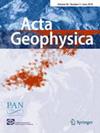Interpretation of Gravity and Gamma-Ray Spectrometry Data in Low Temperature Hydrothermal Systems, Southeastern Part of Fukuoka, Japan
IF 2.1
4区 地球科学
Q2 GEOCHEMISTRY & GEOPHYSICS
引用次数: 0
Abstract
The Hakata hot springs area is located in Fukuoka City, which is in the southwestern part of Japan. Gamma-ray and gravity surveys were conducted to understand the relationship between the low-temperature hydrothermal systems and geophysical data of the area. The depth of the reservoir basement, which was derived from gravity data, gradually deepens toward the east; it includes some steep depth gradients in the Hakata hot springs area. High intensities of gamma-rays were detected around these gradients. In addition, higher hot spring temperatures and flow rates can be observed in this area. These results indicate that some part of the level of the basement where the hot springs are concentrated is a part of the Kego Fault and is similar to the fracture zone created by past activities of the fault. Moreover, these steep depth gradients act as a path for hot spring water from the deeper side of the granitic body to the surface.日本福冈东南部低温热液系统重力和伽马射线能谱数据解释
博多温泉区位于日本西南部的福冈市。通过伽玛射线和重力测量了解该地区低温热液系统与地球物理数据的关系。重力资料显示,储层基底深度自北向东逐渐加深;它包括博多温泉地区的一些陡峭的深度梯度。在这些梯度附近探测到高强度的伽马射线。此外,在该地区可以观察到较高的温泉温度和流量。这些结果表明,基岩中温泉集中的部分水平为科古断裂的一部分,与该断裂以往活动形成的断裂带相似。此外,这些陡峭的深度梯度作为温泉水从花岗岩体的较深一侧到表面的路径。
本文章由计算机程序翻译,如有差异,请以英文原文为准。
求助全文
约1分钟内获得全文
求助全文
来源期刊

Acta Geophysica
地学-地球化学与地球物理
CiteScore
3.90
自引率
13.00%
发文量
251
审稿时长
5.3 months
期刊介绍:
Acta Geophysica is open to all kinds of manuscripts including research and review articles, short communications, comments to published papers, letters to the Editor as well as book reviews. Some of the issues are fully devoted to particular topics; we do encourage proposals for such topical issues. We accept submissions from scientists world-wide, offering high scientific and editorial standard and comprehensive treatment of the discussed topics.
 求助内容:
求助内容: 应助结果提醒方式:
应助结果提醒方式:


